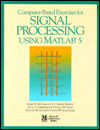![]()
Covered Material of textbook #1
 Alan V. Oppenheim, Ronald W. Schafer, and
John R. Buck, Discrete-Time Signal Processing, 2nd ed.,
Prentice
Hall, 1998.
Alan V. Oppenheim, Ronald W. Schafer, and
John R. Buck, Discrete-Time Signal Processing, 2nd ed.,
Prentice
Hall, 1998.
Chapter 2
| Section 2.1 | |
| Section 2.2 | |
| Section 2.3 | |
| Section 2.4 | |
| Section 2.5 | |
| Section 2.6 | |
| Section 2.7 | |
| Section 2.8 | |
| Section 2.9 | |
| Section 2.10 - Only Equations (2.195) and (2.204) and how to use them |
Chapter 4
| Section 4.1 | |
| Section 4.2 | |
| Section 4.3 | |
| Section 4.4 (exclude 4.4.2) | |
| Section 4.5 | |
| Section 4.6 | |
| Section 4.8 |
Chapter 7
| Section 7.0 (specifications for discrete-time filters) | |
| Section 7.1 (Impulse invariance and bilinear transformation methods) | |
| Section 7.2 (windowing method for FIR filter design) | |
| Section 7.3 (formulation of optimal design of FIR filters) | |
| All designs discussed in the Matlab code are VERY IMPORTANT. |
Chapter 8
| Section 8.1 | |
| Section 8.2 | |
| Section 8.3 | |
| Section 8.4 | |
| Section 8.5 | |
| Section 8.6 | |
| Section 8.7 |
Chapter 10
| Section 10.1 | |
| Section 10.2 | |
| Section 10.3 (exclude 10.3.2) | |
| Section 10.4 (Only spectrogram display example) | |
| Section 10.6 (Only definition of periodogram and its averaging using DFT) |
Chapter 11
| Section 11.4 (Hilbert transform for discrete sequences) |
![]()
Covered Material from Textbook #2
 C. Sidney
Burrus, James C. McClellan, et al., Computer-Based Exercises for
Signal Processing Using Matlab, Prentice Hall, 1993.
C. Sidney
Burrus, James C. McClellan, et al., Computer-Based Exercises for
Signal Processing Using Matlab, Prentice Hall, 1993.
| Chapter 3: Spectrum Analysis | |
| Chapter 8: Discrete-Time Filter Design | |
| Chapter 11: Linear Prediction (Handout) |